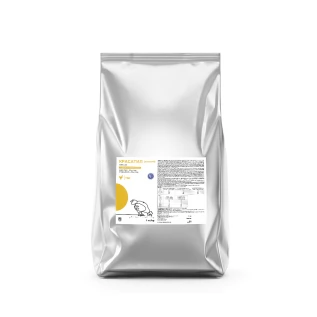| Ingredients: | dextrin, lutein, lactose |
| Application: | Orally with food |
| Type of formulation: | feed mixture |
Description
Powder
Composition
1 g of the feed mixture contains:
- dextrin (13.3.5) - 850 mg;
- lutein (E161b) - 100 mg;
- lactose (8.9.1) - 50 mg.
Mass fraction of moisture, max 6.0%.
Pharmacological properties
The effect of the feed mixture is due to the presence of lutein in its composition, which belongs to the carotenoid xanthophyll, responsible for the yellow-orange colour of many fruits and vegetables.
Lutein is a yellow pigment, mainly based on lutein with a high percentage of trans-isomers, carefully stabilised, homogenised and saponified to ensure maximum intestinal absorption and biological efficacy. When added to feed and consumed by animals, this pigment is absorbed in the body and enhances the colour intensity of broiler skin, egg yolk and salmonid meat, which increases the consumer value of the products.
Lutein plays an important antioxidant role in animal nutrition. As an antioxidant, lutein helps to protect animal cells from damage caused by free radicals, which are by-products of normal metabolic processes and can damage cell membranes, DNA and other cellular components. Free radicals can cause oxidative stress, which is associated with many health problems in animals.
Lutein is also an important pigment in animal tissues that gives colour to various tissues, including skin, feathers and eyes. For example, in poultry, lutein is responsible for the yellow colour of egg yolks, skin and meat. In fish, lutein gives a bright colour to the scales, and in birds, it gives colour to the feathers. In mammals, lutein is present in their eyes, where it helps protect sensitive tissues from damage caused by high-energy blue light.
One of the uses of lutein in livestock is to enhance the pigmentation of egg yolks. Egg yolks are naturally yellow in colour due to the presence of carotenoids, and lutein is one of the most abundant carotenoids found in egg yolks, and by adding lutein to the diet of laying hens, egg producers can increase the amount of lutein in eggs and improve their nutritional value. In addition to enhancing the pigmentation of egg yolks, lutein can also improve the health and well-being of the laying hens themselves.
Another potential use of lutein in livestock production is to improve the colour and flavour of poultry meat. Lutein accumulates in the skin and muscle tissue of poultry and can contribute to the yellow colour of chicken skin and meat. By adding lutein to the diet of broiler chickens, producers can improve the colour and flavour of their meat products, which can lead to increased consumer demand.
Adding lutein to the chicken diet can also improve the shelf life of eggs. Lutein has antimicrobial properties, which can help prevent the growth of harmful bacteria in eggs and extend the shelf life of eggs and reduce the risk of foodborne illness.
Lutein is also important in aquaculture, especially for the health and colouration of fish and shrimp. In fish, lutein is responsible for the bright colour of scales and meat, which are important for attracting mates and deterring predators.
Lutein is a powerful antioxidant that can provide important benefits in aquaculture by helping to protect fish and shrimp from oxidative stress. Oxidative stress occurs when there is an imbalance between the production of reactive oxygen species (ROS) and the body's ability to detoxify them. ROS can damage cells and tissues, leading to inflammation, disease and reduced growth rates.
Application
It is used for pigmentation of egg yolks, broiler skin and meat of salmonids.
Dosage
Feed mixture KRASATIL (yellow) is mixed with feed in doses of:
Broilers:
|
Age
of the poultry |
Minimum
dose of KRASATIL (yellow), g/t
of feed |
Average
recommended dose of KRASATIL (yellow), g/t
of feed |
Maximum
dose of KRASATIL (yellow), g/t
of feed |
|
0-21 days |
80 |
120 |
150 |
|
22-35 days |
120 |
160 |
200 |
|
36+ |
160 |
250 |
300 |
Laying hens:
|
Colour
of egg yolk |
Minimum
dose of KRASATIL (yellow), g/t
of feed |
Maximum
dose of KRASATIL (yellow), g/t
of feed |
|
8/9 |
10 |
15 |
|
9/10 |
10 |
15 |
|
10/11 |
10 |
15 |
|
11/12 |
15 |
20 |
|
12/13 |
20 |
25 |
|
13/14 |
20 |
25 |
Fish of the salmon family – 200-800 g of feed mixture per 1 tonne of feed.
Contraindications
Not specified.
Warnings
When working with the feed mixture, it is necessary to comply with generally accepted sanitary and hygienic standards and rules at work. Use only for the intended purpose.
Form of release
1 kg bags and 10 and 25 kg sacks.
Storage
Store in a dry place protected from sunlight and humidity at temperatures between 25°C and 30°C.
To prevent oxidation and maintain the stability of the feed mixture, it should be stored in an airtight container after opening.
Shelf life
24 months.
Name and location of the manufacturer(s)
Vetsintez Limited Liability Company
30, Bobanych Taras St., Kharkiv, 61001, Ukraine
Registration number of the power plant: d-UA-20-8
